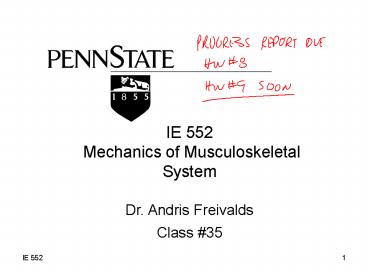My Class - PowerPoint PPT Presentation
1 / 31
Title: My Class
1
IE 552 Mechanics of Musculoskeletal System Dr.
Andris Freivalds Class 35
2
Gross Posture Analysis OWAS
- Owaco Working Posture Analysis System (OWAS,
Karhu, 1977) - Developed at the Finnish Institute of
Occupational Health in 1970s - For use in steel industry
- Evaluation of posture at regular intervals
- Four categories back, upper limbs, lower limbs,
force (lt10, lt20, gt20 kg)
3
2151 bent back, both arms below shoulders,
kneeling, lt10 kg load
4
Gross Posture Analysis OWAS
- Next produce frequency distributions of OWAS
postures - Rate into four level of action categories
- Test-retest correlations high, r 0.97
- Quick but simple means of categorizing gross
postures
5
Gross Posture Analysis - RULA
- Rapid upper limb assessment (RULA)
- Developed at the Univ. of Nottingham
- (McActamney and Corlett, 1993)
- Upper limb postures from Group A (for left or
right side) are combined based on Table A to
yield an upper limb score - Trunk/leg postures from Group B are combined
based on Table B to yield a trunk score
6
RULA Group A
7
RULA Table A
8
RULA Group B
9
RULA Table B
10
RULA Grand Score Table
11
RULA
- These scores are adjusted upwards
- 1 if mainly static posture (gt1 min) or
. repeated gt 4/min - 1 if 2-10 kg intermittent loads
- 2 if 2-10 kg static or repeated loads
- 3 if gt10 kg static or repeated loads
- Both scores combined into grand score
- Determines risk or action level
12
RULA
- If RULA grand score
- 1 or 2 acceptable conditions
- 3 or 4 change may be needed
- 5 or 6 change required soon
- 7 or 8 change required immediately
- Good correlation with discomfort
- Probably best for postural evaluations
- Example t-shirt turning, 12/min
13
(No Transcript)
14
RULA A 4 1 (Freq gt 4/min)
15
1 due to static posture
16
Grand score 4, Borderline risk
17
Quantitative Upper Limb WRMSD Risk Assessment
Strain Index 1
- Strain Index (SI, Moore and Garg, 1995)
- Rate 6 task variables (Table 1)
- intensity of exertion
- duration of exertion
- efforts per minute
- wrist posture
- speed of work
- duration of task
18
Strain Index Rating Criteria Table 1
19
Strain Index - 2
- Convert SI ratings to multipliers (Table 2)
- Multiply for final SI score
- Scores gt 5 considered hazardous
- Good validation
- identified 24/25 risky/non-risky jobs
- sensitivity 0.86
- specificity 0.79
20
Strain Index Multipliers - Table 2
21
Strain Index - 2
- Example using Strain Index
- Consider task with
- 20 MVC exertions
- over 60 of a cycle
- with 12 efforts per minute
- with 18 ulnar deviations
- at 95 of normal pace
- for a full 8-hr shift
22
(No Transcript)
23
Quantitative Upper Limb WRMSD Risk Assessment
- The example job is hazardous (13.5gt5)
- Overall, SI improvement over RULA
- Considers more than basic postures
- Considers upper extremities
- Considers effort, intensity, pace
- Greater quantitative detail
- Next step ? data driven risk models
24
Data Driven Upper Limb WRMSD Risk Assessment
PSU CTD Risk Index
- Developed at Penn State University
- From 13 years of Center for CTD work
- Wrist postures fed directly to model
- From touch glove system (using force sensitive
resistors and Data Glove) - Industrial WRSMD data tunes model
- Final score - predicted incidence rate
- Details - Seth, Weston, Freivalds (1999)
25
(No Transcript)
26
PSU CTD Risk Index - 2
- Validation on 24 jobs with 288 workers
- Regression of predicted vs. actual IR
- Significant (p lt 0.001) correlation, r2 0.52
- By 5th trial, analysis time down to 12 min.
- Test/retest reliability was up to r20.99
- 2nd validation on 91 meatpackers, r2 0.75
27
(No Transcript)
28
PSU CTD Risk Index - 3
- Also a paper and pencil version
- Quicker, simpler to use for industry
- Validated with PC version
- On 12 sewing jobs
- Significant (p lt 0.001) correlation of scores
with r2 0.66 - Action level 1.0 (similar to NIOSH Lifting)
29
(No Transcript)
30
PSU CTD Risk Index P/P 1
31
PSU CTD Risk Index P/P 2































